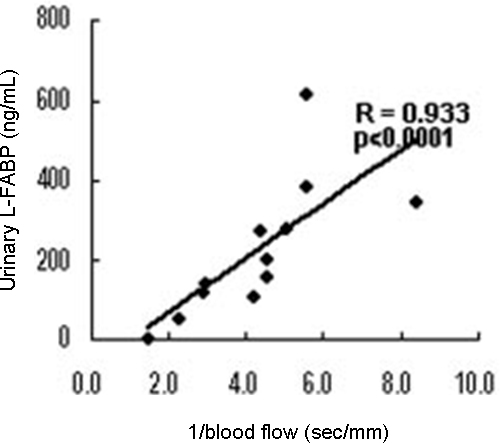Key words: microcirculation, acute ischemic injury
Urinary L-FABP excretion mechanism
L-FABPs are fatty acid binding proteins with a molecular weight of 14kDa present in abundance in the cytoplasm of human renal proximal tubular cells (in healthy subjects). Human fabp gene expression has been confirmed mainly in the liver, kidneys and intestine, and in those transcriptional regulation regions, coupling regions for transcription factors relating to ischemia and fatty acids metabolism such as hypoxia-inducible factor 1 (HIF-1), hepatocyte nuclear factors (HNF-4, HNF-1), and peroxisome proliferator-activated receptor (PPAR) exist.
It has been proven that in a normal human kidney, L-FABPs located in the cytoplasm of the proximal tubules are rapidly excreted into the lumen in response to ischemia and oxidative stress (FIG. A-3)[1].
A-1: Non-invasive CCD video recording

Method
Peritubular capillary blood flow immediately after kidney reperfusion during a human living kidney transplantation was measured using non-invasive CCD video recording, and compared with L-FABP value in simultaneously collected first urine (FIG. A-1).
Results
Urinary L-FABP had a very high correlation (R = 0.933, p <0.0001) with the reciprocal of peritubular capillary blood flow, and it became clear that renal hypoxic stress could be detected by urinary L-FABP in the different mechanism from clasically existing urinary markers (NAG, α1MG, β2MG) (FIG. A-2).
A-2: Correlation between peritubular capillary blood flow and urinary L-FABP

A-3: The localization of L-FABP (immunohistochemical staining in renal biopsy samples)
It is noteworthy that tubular cytoplasmic L-FABP was shown to be excreted in the lumen immediately after reperfusion (FIG. A-3).

Urinary L-FABP has a direct correlation with microcirculation
disorder reflecting proximal tubular ischemia.
References
- [1] Yamamoto, T. et al., Renal L-type fatty acid-binding protein in acute ischemic injury. J Am Soc Nephrol. 18(11): 2894-2902, 2007. PubMed